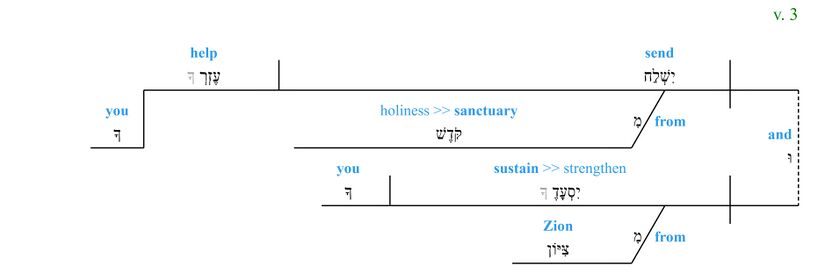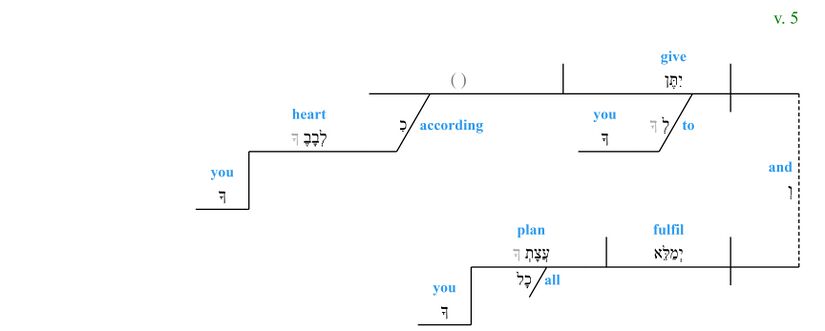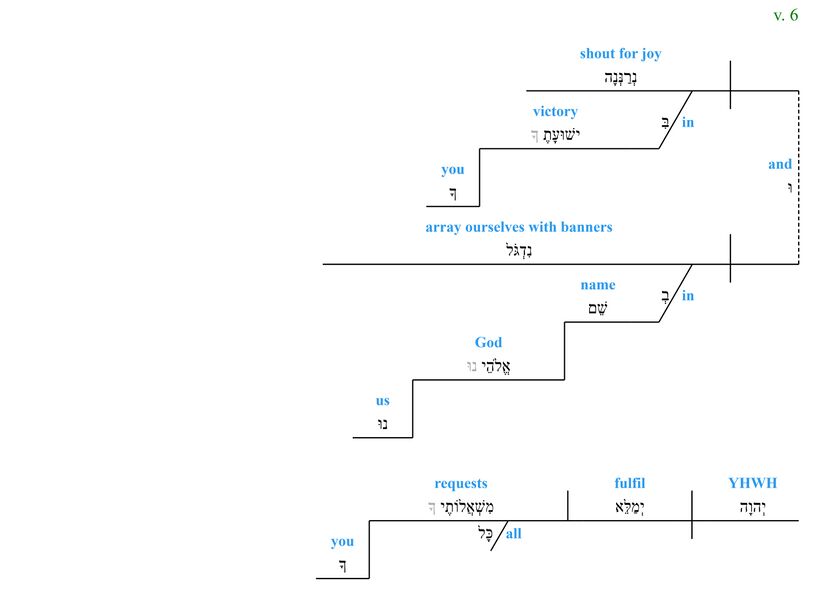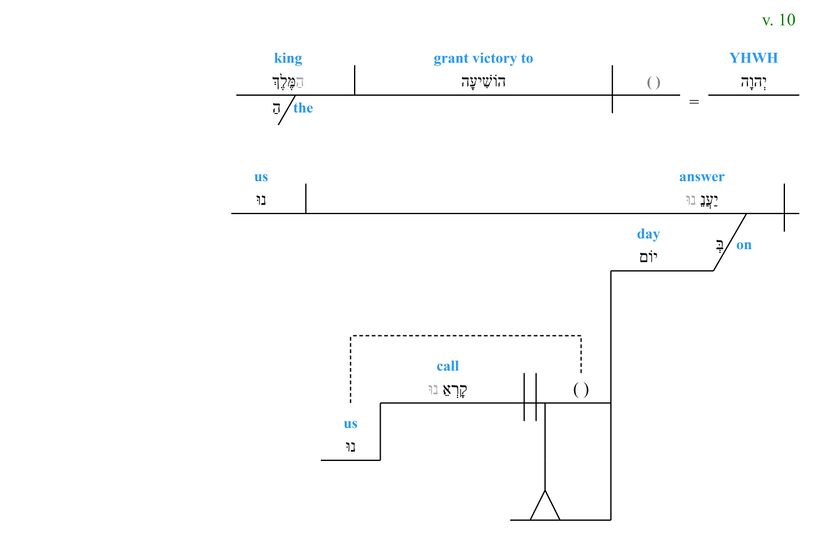Psalm 20 Grammar
About the Grammar Layer
The grammar layer visually represents the grammar and syntax of each clause. It also displays alternative interpretations of the grammar. (For more information, click "Expand" to the right.)
The grammatical diagram provides a way to visualise how different parts of a sentence work together. It represents the “surface-level” grammar, or morphosyntax, of a sentence. Morphosyntax includes both the form of words (morphology) and their placement in the sentence (syntax). This approach to visualising the text, based on the Reed-Kellogg diagramming method, places the grammatical subject in one slot, the verb in another slot, and modifiers and connectives in other slots.
For a detailed description of our method, see the Grammar Creator Guidelines.
Grammar Visuals for Psalm 20
| Visualization | Description |
|---|---|
| The clause is represented by a horizontal line with a vertical line crossing through it, separating the subject and the verb. | |
| The object is indicated by a vertical line that does not cross the horizontal line of the clause. Infinitives and participles may also have objects. If the direct object marker (d.o.m.) is present in the text, it appears in the diagram immediately before the object. If the grammar includes a secondary object, the secondary object will appear after the object, separated by another vertical line that does not cross the horizontal line of the clause. | |
| The subject complement follows the verb (often omitted in Hebrew) separated with a line leaning toward the right. It can be a noun, a whole prepositional phrase or an adjective. The later two appear modifying the complement slot. | |
| When a noun further describes or renames the object, it is an object complement. The object complement follows the object separated by a line leaning toward the right. | |
| In a construct chain, the noun in the absolute form modifies the noun in the construct form. | |
| Participles are indicated in whatever position in the clause they are in with a curved line before the participle. Participles can occur as nominal, where they take the place of a noun, predicate, where they take the place of a verb, or attributive, where they modify a noun or a verb similar to adjectives or adverbs. | |
| Infinitives are indicated by two parallel lines before the infinitive that cross the horizontal line. Infinitive constructs can appear as the verb in an embedded clause. Infinitive absolutes typically appear as an adverbial. | |
| The subject of the infinitive often appears in construct to it. In this situation, the infinitive and subject are diagrammed as a construct chain. | |
| The object of the infinitive is indicated by a vertical line that does not cross the horizontal line of the infinitival clause. | |
| Modifiers are represented by a solid diagonal line from the word they modify. They can attach to verbs, adjectives, or nouns. If modifying a verb or adjective, it is an adverb, but if modifying a noun, it is an adjective, a quantifier, or a definite article. If an adverb is modifying a modifier, it is connected to the modifier by a small dashed horizontal line. | |
| Adverbials are indicated by a dashed diagonal line extending to a horizontal line. These are nouns or infinitives that function adverbially (modifying either a verb or a participle), but are not connected by a preposition. | |
| Prepositional phrases are indicated by a solid diagonal line extending to a horizontal line. The preposition is to the left of the diagonal line and the dependent of the preposition is on the horizontal line. They can modify verbs (adverbial) or nouns (adjectival). | |
| Embedded clauses are indicated by a "stand" that looks like an upside-down Y. The stand rests in the grammatical position that the clause fulfills. Extending from the top of the stand is a horizontal line for the clause. If introduced by a complementizer, for example כִּי, the complementizer appears before the stand. Embedded clauses can stand in the place of any noun. | |
| When clauses are joined by a conjunction, they are compound clauses. These clauses are connected by a vertical dotted line. The conjunction is placed next to the dotted line. | |
| Within a clause, if two or more parts of speech are compound, these are represented by angled lines reaching to the two compound elements connected by a solid vertical line. If a conjunction is used, the conjunction appears to the left of the vertical line. Almost all parts of speech can be compound. | |
| Subordinate clauses are indicated by a dashed line coming from the line dividing the subject from the predicate in the independent clause and leading to the horizontal line of the subordinate clause. The subordinating conjunction appears next to the dashed line. | |
| Relative clauses also have a dashed line, but the line connects the antecedent to the horizontal line of the relative clause. The relative particle appears next to the dashed line. | |
| Sentence fragments are represented by a horizontal line with no vertical lines. They are most frequently used in superscriptions to psalms. They are visually similar to discourse particles and vocatives, but most often consist of a noun phrase (that does not refer to a person or people group) or a prepositional phrase. | |
| In the body of the psalm, a horizontal line by itself (with no modifiers or vertical lines) can indicate either a discourse particle or a vocative (if the word is a noun referring to a person or people group). A discourse particle is a conjunction or particle that functions at the discourse level, not at the grammatical level. Vocatives can appear either before or after the clause addressed to them, depending on the word order of the Hebrew. | |
| Apposition is indicated by an equal sign equating the two noun phrases. This can occur with a noun in any function in a sentence. |
| Hebrew text colors | |
|---|---|
| Default preferred text | The default preferred reading is represented by a black line. The text of the MT is represented in bold black text. |
| Dispreferred reading | The dispreferred reading is an alternative interpretation of the grammar, represented by a pink line. The text of the MT is represented in bold pink text, while emendations and revocalizations retain their corresponding colors (see below). |
| Emended text | Emended text, text in which the consonants differ from the consonants of the Masoretic text, is represented by bold blue text, whether that reading is preferred or dispreferred. |
| Revocalized text | Revocalized text, text in which only the vowels differ from the vowels of the Masoretic text, is represented by bold purple text, whether that reading is preferred or dispreferred. |
| (Supplied elided element) | Any element that is elided in the Hebrew text is represented by bold gray text in parentheses. |
| ( ) | The position of a non-supplied elided element is represented by empty black parentheses. For example, this would be used in the place of the noun when an adjective functions substantivally or in the place of the antecedent when a relative clause has an implied antecedent. |
| Gloss text colors | |
|---|---|
| Gloss used in the CBC | The gloss used in the Close-but-Clear translation is represented by bold blue text. |
| Literal gloss >> derived meaning | A gloss that shows the more literal meaning as well as the derived figurative meaning is represented in blue text with arrows pointing towards the more figurative meaning. The gloss used in the CBC will be bolded. |
| Supplied elided element | The gloss for a supplied elided element is represented in bold gray text. |
v. 1
v. 2
v. 3
- Instead of the MT reading (“From sanctuary” - מִקֹּדֶשׁ), the Targum and Syriac versions contain the suffix pronoun third person, masculine, singular (which in Hebrew would be מִקְדָּשֹׁו - “From his sanctuary”). Those in favor of the emendation suggest the suffix pronoun was omitted in the MT due to haplography because the word subsequent to מִקֹּדֶשׁ starts with a waw (מִקֹּדֶשׁ וּמִצִּיֹּון) (cf. Craige 2004: 184). Some modern translations (NLT: "from his sanctuary;" CEV, GNT, NET: "from his temple") follow the reading with the suffix pronoun (מִקְדָּשֹׁו) represented in blue as an emendation. Nevertheless, the MT reading is supported by the absence of the suffix pronoun in the Greek version.
v. 4
- Singular or plural?
- Offering (מִנְחֹתֶךָ) “is a plural written defectively: מִנְחֹתֶךָ. A few manuscripts write it fully: מִנְחֹתֶיךָ. The Greek text and Jerome have the singular, equal to מִנְחָתְךָ, which the form in the text without the yod would suggest to the translators” (Ross 2011, 489).
- Burnt-offering (וְעֹולָתְךָ) is read as singular in the MT; however, a few manuscripts along with the Peshitta and the Targum read the plural form עֹולֹתֶיךָ.
- Manuscript evidence can support reading the nouns as either singular or plural (cf. Jacobson and Tanner 2014, 217, and Craigie 2004, 184). However, we have chosen to follow the singular reading (מנחתך and ועולתך) instead of the plural reading (מנחתיך and ועולתיך) for several reasons. First, the consonantal text of the MT for both words uses singular orthography (i.e. the expected orthography of the plural would contain a yod - מנחתיך and ועולתיך). In turn, the LXX translates both nouns as singular. Second, when מִנְחָה and עֹלַה appear in parallel, they tend to be singular (cf. Num. 28:31, 29:6; Jer. 14:12). Third, the nouns should match in number because the grain offering and burnt offering would have been offered together (see Briggs 1906: 181). In this case, כָּל in כל־מנחתך is similar to the occurrences in Lev. 6:16 (וְכָל־מִנְחַת כֹּהֵן - every offering of a priest), Num. 18:9 (כָל־מִנְחָתָם - every offering of theirs), and 1 Sam. 2:29 (כָּל־מִנְחַת יִשְׂרָאֵל לְעַמִּי - every offering of my people Israel). Likewise, we opt to translate כל־מנחתך as "every offering of yours." This translation reflects the consonantal text of the MT (which uses singular orthography - מנחתך your offering and ועולתך your burnt offering). Hence, v. 4 translates as "May he remember every offering of yours and accept your burnt offering."
- The verb דשן in the Piel stem occurs only five times in the Bible (Ps. 20:4; 23:5; Exod. 27:3; Num. 4:13; Prov. 15:30), and it has four different senses (cf. SDBH and AnLexHeb). In Ps. 20:4, it occurs as a Piel yiqtol 3ms with an unusual ending: יְדַשְּׁנֶה (May he accept).
- Although we prefer the MT reading יְדַשְּׁנֶה, scholars have suggested three other alternatives. We will consider each of them before presenting the reasons for our preferred view.
- Based on the BHS critical apparatus, one alternative is to read the MT verb יְדַשְּׁנֶה as יְדַשְּׁנֶהָ (verb דשן plus a 3fs pronominal suffix, which could be written either as נֶהָ- or נָהּ- [cf. BDB]). This option would result in a translation as "May he accept it" (Gesenius [§48d, 130], Bauer and Leander [§45c, 329], BDB, and HALOT).
- A second option mentioned in the BHS critical apparatus is to emend יְדַשְּׁנֶה to יִדְרְשֶׁנָּה ("May he require it" cf. DCH; cf. Ehrlich 1905: 41), and assume that the ר has dropped out (Kraus 1988: 278; he translates as "May he ask about [it]" [277]). In this emendation, the 3fs pronominal suffix is accompanied by an energic nun resulting in the form נָּה. The energic nun would serve a phonetic purpose but would not have an effect on the meaning (see more on Joüon §61f, 160 and Gesenius §58i, 157-158).
- A third proposal (not included in BHS) is to read the word as יִרְצֶנָה (Cheyne 1904: 82), meaning "May he be pleased with it."
- We prefer the MT verb יְדַשְּׁנֶה and read it as a rare third-person cohortative/volitive form (Briggs 1906: 181) identical in meaning to a typical jussive ("May he accept"). Morphologically, Dallaire has identified some rare occurrences of the prefix and paragogic ה ָ occurring in second and third-person cohortative verbs. יְדַשְּׁנֶה is one of those occurrences (cf. Dallaire 2014: 108-109; other examples include Deut. 33:16 [תָּבֹ֨ואתָה֙]; Job 11:17 [תָּ֝עֻ֗פָה]; Isa. 5:19 [וְתָבֹ֗ואָה]). Additionally, the verb יְדַשְּׁנֶה ("May he accept") fits the context of the psalm better than יִדְרְשֶׁנָּה ("May he require it"). The petition was not for God to require the offerings but to accept them, which would result in divine protection and favor on the day of trouble (cf. Briggs 1906: 178, Barnes 1868: 179). Last, while the various alternative readings are mentioned in the scholarly literature, they are not reflected in modern translations.
- Although we prefer the MT reading יְדַשְּׁנֶה, scholars have suggested three other alternatives. We will consider each of them before presenting the reasons for our preferred view.
v. 5
v. 6
- The MT reads נִדְגֹּל ("May we array ourselves with banners") possibly from the root דגל (to raise, to lift up a banner). Based on the BHS critical apparatus, the LXX has the form μεγαλυνθησόμεθα (We shall be magnified), perhaps reading נַגְדִּל or נְגַדֵּל instead of נִדְגֹּל (MT reading). Therefore, the LXX as well as Jerome’s translations (magnificabimur - iuxta LXX) might be assuming the root גדל (be great) instead of דגל (raise a banner). The BHS suggests the emendation נָגִיל (we will/shall rejoice). According to Craigie, the LXX reading “μεγαλυνθησόμεθα ‘we shall be magnified,’ presupposing נגדל, is probably an error, or was based on a Heb. text in which (erroneous) metathesis had taken place” (Craigie 2004, 184). Some modern translations have opted to follow the LXX reading resulting in the following translations:
- "We will rejoice in the name of our God!" (NET).
- "and celebrate your triumph by praising our God" (GNT).
v. 7
v. 8
- From the verb boast נַזְכִּיר (v. 8b), the verb יַזְכִּירוּ or הִזְכִּירוּ could be supplied for v. 8a. In addition, for the verb נַזְכִּיר (v. 8b), the LXX has μεγαλυνθησόμεθα as in v. 6 (perhaps reading נַגְדִּל or נְגַדֵּל or נָגִיל - cf. note on v.6). Based on the BHS critical apparatus, Syriac translators seem to have read the MT word נַזְכִּיר (from the root זכר - to remember) as נַגְבִּיר (from the root גבר to be strong, to overpower). Syriac: ܢܥܫܢ - "ˁšn vb. e/a to be strong" (cf. CAL).
- Hiphil of זכר plus בְּ - "To make laudatory mention of a matter, to praise it, and therefore indirectly to boast of it, glory in it" Delitzsch 1883, 363). זכר verb hiphil "= causative action by which humans or deities cause information that is stored in someone else's mind to be reprocessed by speaking about it -- to bring to remembrance; to mention" (SDBH).
- LXX: "οὗτοι ἐν ἅρμασιν καὶ οὗτοι ἐν ἵπποις, ἡμεῖς δὲ ἐν ὀνόματι Κυρίου θεοῦ ἡμῶν μεγαλυνθησόμεθα."
- LXX reads μεγαλυνθησόμεθα from "μεγαλύνω, exalt; glorify; magnify" (LXGRCANLEX).
- μεγαλύνω: to praise a person in terms of that individual’s greatness—‘to praise the greatness of" (Louw-Nida 1996: 429).
- Jerome’s translation (iuxta LXX): "hii in curribus et hii in equis nos autem in nomine Domini Dei nostri invocabimus."
- It reads invocabimus from invocare (to call upon, pray for).
- Jerome’s translation (iuxta Hebraeos): "hii in curribus et hii in equis nos autem nominis Domini Dei nostri recordabimur."
- It reads recordabimur from recordare (to remember, call to mind).
- Targum: אילין ברתיכין ואילין בסוסון ואנחנא בשום ייי אלהנא נדכר
- נדכר from דכר to remember, recall, remind (CAL)
- Syriac: ܗܠܝܢ ܒܡܪ̈ܟܒܬܐ ܘܗܠܝܢ ܒܪ̈ܟܫܐ܂ ܘܚܢܢ ܒܫܡܗ ܕܡܪܝܐ ܐܠܗܢ ܢܥܫܢ
- ܢܥܫܢ܂ to be strong, to overcome, to be heavy (CAL)
- English translations also differ on their reading of the verb in v. 8b
- NIV, ESV, CEV, GNT, NET: to trust
- NLT, NEB, REB: to boast
- NASB: to praise
- CSB, NRSV: to take pride
- NJB, JPS, 1985: to call on
v. 9
v. 10
- The Masoretic accentuation includes an athnach below הוֹשִׁיעָה (Grant victory!), suggesting a break between יְהוָה הוֹשִׁיעָה (YHWH, grant victory!) and הַמֶּלֶךְ (the king). The BHS editors propose that the athnach should be placed under הַמֶּלֶךְ (the king) instead. Although both readings have supporting evidence, we have opted to place the division after הַמֶּלֶךְ (the king). As a result הַמֶּלֶךְ (the king) is the direct object of הוֹשִׁיעָה (YHWH, grant victory to the king!). Please see the exegetical issue The Division of Psalm 20:10 for detailed information.





























